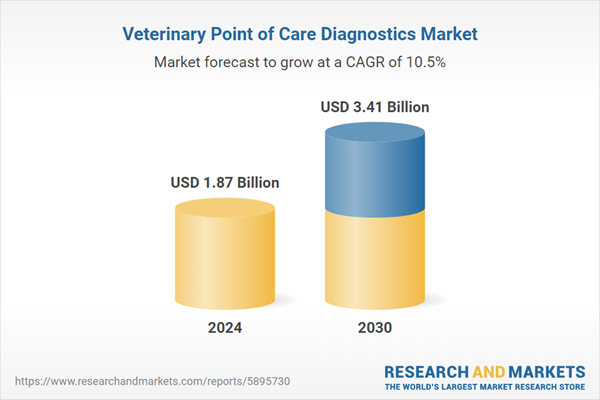Speak directly to the analyst to clarify any post sales queries you may have.
10% Free customizationThis report comes with 10% free customization, enabling you to add data that meets your specific business needs.
Key Market Drivers
Increasing Pet Ownership
The growing global trend of pet ownership significantly contributes to the expansion of the veterinary point-of-care diagnostics market. A larger population of pet owners results in an increased demand for veterinary services, including diagnostics. This trend spans traditional pets like cats and dogs, as well as exotic animals, broadening the market landscape. For instance, in 2024, approximately 66.0% of U.S. households, or 86.9 million homes, owned a pet. The adoption of foster pets is also rising, contributing to the overall increase in pet populations. As pet ownership grows, so does the investment in pet health, with owners increasingly willing to spend on advanced diagnostics and treatments. This shift is a key factor driving the demand for point-of-care diagnostic solutions, which offer rapid and accurate assessments at the site of care.Key Market Challenges
Cost Barriers
Cost remains a major challenge in the adoption of veterinary point-of-care diagnostics. The high costs associated with the development, production, and maintenance of these devices can hinder widespread implementation. Advanced technologies and specialized materials used in these diagnostics increase manufacturing expenses, which can be difficult for small veterinary clinics to manage. Ongoing maintenance, calibration, and software updates further contribute to the total cost of ownership. Additionally, the cost of consumables and reagents required for testing may pose financial challenges for pet owners, limiting the frequency and accessibility of diagnostic services. These economic constraints can affect the adoption rate of point-of-care diagnostics, particularly in regions with limited healthcare budgets.Key Market Trends
Rise in Telemedicine and Remote Monitoring
Telemedicine and remote monitoring are transforming the veterinary point-of-care diagnostics market. Enabled by advancements in digital communication and diagnostic technologies, these tools allow veterinarians to consult with pet owners remotely and monitor animal health in real time. Point-of-care devices play a crucial role by facilitating the collection and transmission of health data from at-home kits or wearable sensors. This trend increases accessibility to veterinary care, especially in remote or underserved areas, and reduces stress for animals by minimizing clinic visits. The COVID-19 pandemic accelerated this shift, highlighting the importance of remote health monitoring for continuous care. By integrating diagnostics with telemedicine platforms, veterinarians can offer proactive and personalized care, improving outcomes while engaging pet owners in managing their animals' health.Key Market Players
- Zoetis Inc.
- IDEXX Laboratories, Inc.
- Virbac SA
- Heska Corporation
- Thermo Fisher Scientific, Inc
- Mindray Medical International Limited
- Esaote S.P.A.
- FUJIFILM Corporation
- Woodley Equipment Company Ltd
- Getein Biotech
Report Scope:
In this report, the Veterinary Point of Care Diagnostics Market has been segmented into the following categories, in addition to the industry trends which have also been detailed below:Veterinary Point of Care Diagnostics Market, Product:
- Consumables
- Reagents
- Kits
- Instruments & Devices
Veterinary Point of Care Diagnostics Market, Animal Type:
- Companion Animals
- Livestock Animals
Veterinary Point of Care Diagnostics Market, Sample Type:
- Blood/Plasma/Serum
- Urine
- Fecal
- Others
Veterinary Point of Care Diagnostics Market, Indication:
- Infectious Disease
- General Ailments
- Others
Veterinary Point of Care Diagnostics Market, Testing Category:
- Hematology
- Diagnostic Imaging
- Bacteriology
- Virology
- Cytology
- Clinical Chemistry
- Parasitology
- Serology
- Others
Veterinary Point of Care Diagnostics Market, End User:
- Veterinary Hospitals & Clinics
- Home Care Settings
- Others
Veterinary Point of Care Diagnostics Market, By Region:
- North America
- United States
- Mexico
- Canada
- Europe
- France
- Germany
- United Kingdom
- Italy
- Spain
- Asia-Pacific
- China
- India
- South Korea
- Japan
- Australia
- South America
- Brazil
- Argentina
- Colombia
- Middle East and Africa
- South Africa
- Saudi Arabia
- UAE
Competitive Landscape
Company Profiles: Detailed analysis of the major companies present in the Veterinary Point of Care Diagnostics Market.Available Customizations:
With the given market data, the publisher offers customizations according to a company's specific needs. The following customization options are available for the report.Company Information
- Detailed analysis and profiling of additional market players (up to five).
This product will be delivered within 1-3 business days.
Table of Contents
Companies Mentioned
- Zoetis Inc.
- IDEXX Laboratories, Inc.
- Virbac SA
- Heska Corporation
- Thermo Fisher Scientific, Inc
- Mindray Medical International Limited
- Esaote S.P.A.
- FUJIFILM Corporation
- Woodley Equipment Company Ltd
- Getein Biotech
Table Information
| Report Attribute | Details |
|---|---|
| No. of Pages | 182 |
| Published | May 2025 |
| Forecast Period | 2024 - 2030 |
| Estimated Market Value ( USD | $ 1.87 Billion |
| Forecasted Market Value ( USD | $ 3.41 Billion |
| Compound Annual Growth Rate | 10.5% |
| Regions Covered | Global |
| No. of Companies Mentioned | 10 |









